November 13, 2007 at 8:52 pm · Filed under FAQs, Travel / lifestyle musings
As I travel I’ve been asked by friends to keep my eyes open for certain models of vintage Airstreams that are for sale. Out west I find some of the best Airstream hunting, because around any corner there can be a well-preserved vintage trailer sitting in a low-humidity climate, just waiting for someone to come by. California is not the best spot because prices here tend to be high, and only a little of the state is truly arid, but there are still plenty to be had.
Roger heard about a 1978 Airstream Excella 500, 31 feet long, sitting in a salvage yard not far from Visalia. After dropping off the Nissan for its expensive 60,000 mile service, we drove over to the yard to check out the trailer and document it for anyone who might be interested. Roger posted my photos and his on Flickr.
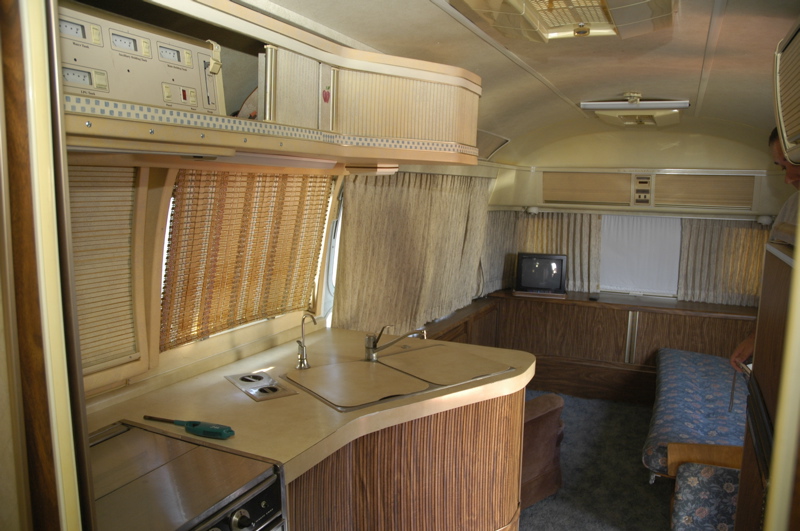 The seller is asking for $7,200 or best offer, which seems a tad high, but the trailer is very well kept. It was clearly loved by someone and maintained. The interior is all original except for fabrics, and it has a good roomy floorplan up front, twin beds amidships, and a spacious rear bath. The body is in good shape with no major dents.
The seller is asking for $7,200 or best offer, which seems a tad high, but the trailer is very well kept. It was clearly loved by someone and maintained. The interior is all original except for fabrics, and it has a good roomy floorplan up front, twin beds amidships, and a spacious rear bath. The body is in good shape with no major dents.
Like a lot of 1970s trailers, it has storage in abundance, tambour doors everywhere, extensive clearcoat peeling, tired axles, fogged Vista-View windows, and lots of potential. I’d expect to drop another $4-5k into it quickly for axles, brakes, tires, leak fixes (I’m sure there are leaks somewhere), new awning fabric, and a bit of floor rot repair near the entry door. A more complete restoration that repaired or replaced the fogged windows, replaced all the fabrics, and included a budget for appliance replacements would probably run $10-20k depending on how nice you wanted it. A full-blown restoration to get it perfect and polished … well, that could cost anything.
The point is that an Airstream can cost almost anything. You can certainly get going on a budget as low as $5k (we did). For a lot of people, the best course is to take an “OK” trailer like this one and upgrade it slowly as you use it. If I were looking for a longer trailer that I could start using right away, I’d consider this one with a working budget of about $10-12k for trailer and initial fixes.
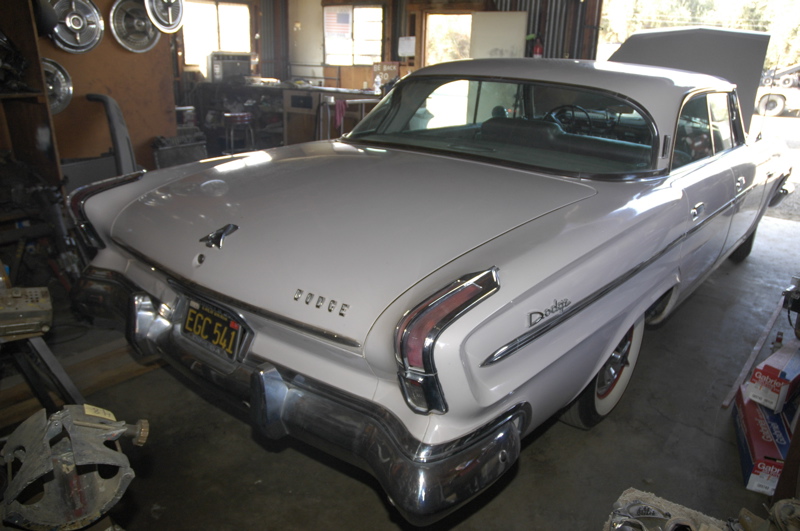 While we were poking around at the salvage yard we also spotted a very tired 1976 Airstream Caravanner 25 (needing a complete restoration and sporting some poorly repaired rear dome segments), and this “so ugly it’s cute” 1962 Dodge 880.
While we were poking around at the salvage yard we also spotted a very tired 1976 Airstream Caravanner 25 (needing a complete restoration and sporting some poorly repaired rear dome segments), and this “so ugly it’s cute” 1962 Dodge 880.
The Dodge is all original. It’s the classic story of the car owned by a little old lady and used only occasionally. 34,000 miles and it shows just a little patina in the form of small rust areas around the corners. It runs and the interior is excellent. I especially like the funky push-button transmission.
I’m intrigued by the idea of using a 1960s car as a tow vehicle for our 1968 Airstream Caravel, but I’m not buying this one yet. The seller wants $6,500 if you’re interested. Photos are also on Roger’s Flickr album.
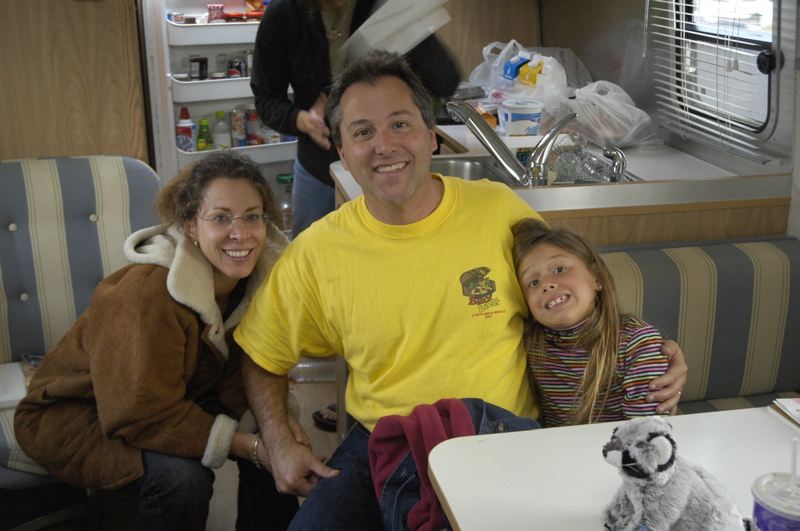
Tomorrow we are moving off. We have mooched a few very nice nights with Roger & Roxy, gotten our errands done, eaten coconut cream pie, and caught up mostly with business. It’s been fun and relaxing being here.
Now we’re heading to the coast to meet up with some Airstream folks who flagged us down a few days ago on our way out of Yosemite: Cynthia, Dennis, and 7-year-old Madison. They’ll courtesy park us at their house, so this is a a great low-cost week, but that’s not the reason we’re going there. It just looks like fun. Good enough reason.
November 12, 2007 at 6:30 pm · Filed under Mobile technology, Tips & Ideas
We are so comfortable here in Roger & Roxy’s courtesy parking spot that we have decided to stay a third night. For a “small” California city, Visalia seems to have everything we need for now. Yesterday we knocked off a lot of our to-do list: propane re-fill, a very short haircut for me, a new external hard drive for the Mac, a huge pile of laundry, groceries, and I got a new cell phone.
OK, explanations: The haircut keeps getting shorter because I find life to be easier with short hair. It’s easier to wash when boondocking on short water supplies, and I can let it grow for a few weeks between haircuts (although this last time I waited a bit too long and ended up with a permanent case of the “bed-head” look.) This one is the shortest yet, approaching a crew cut. Anyone who has known me in the past 40 years may be a bit shocked.
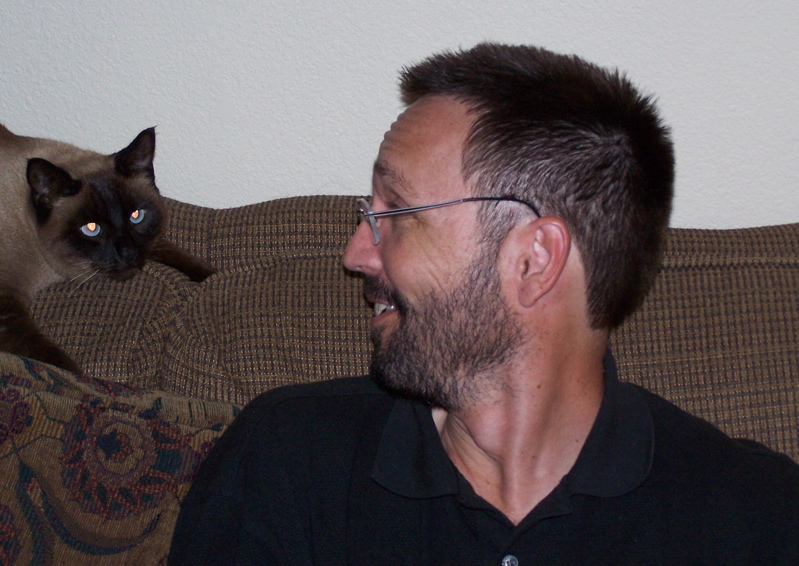
Hard drive: I have need for lots of disk storage because I carry around the complete archives for Airstream Life (layouts, website, articles, correspondence, database, and over 20 gigabytes of photography). The biggest external drives require AC power, which means I would need to run an inverter to use those drives when not plugged in. That is possible, but I find all the cords to be a nuisance, so I use USB-powered drives exclusively.
I was thrilled to find Western Digital’s Passport model that stores 250 gb in a very small form factor and doesn’t need AC power. But when I got it home I found the bad news: it doesn’t work on the Mac Powerbook G4, despite WD’s claim that it is “Mac compatible.” The reason is that it draws more power from the USB port than it should. It works fine with Eleanor’s Mac iBook G4 however. Western Digital has a work-around for this problem, a funky Y-cable that lets it draw power from two USB ports simultaneously, which I will probably get later, although it’s kludgey.
Cell phone: I talk on the phone a lot and believe it or not, under heavy use cell phones do wear out. My last one was purchased in August 2006, when the previous phone croaked out in Idaho. The battery of the replacement phone has had a noticeable loss of capacity and the case is badly worn. I decided to take advantage of Verizon’s upgrade program before the phone died, because the rule of thumb is that cell phones die in the most inconvenient spots. And, this way I’ve got a backup phone in case of failure.
Tomorrow the local Nissan dealer has made room for us on the schedule to get the big 60,000 mile service interval, which will be expensive but is another piece of the mandatory maintenance. That’s 60k miles in two years … yikes … That’s a lot more use from this vehicle than we had originally anticipated. It’s holding up very well, but I wonder if — given our future plans to keep traveling forever — we should consider moving to a diesel vehicle.
We also got a lot of future travel arrangements worked out today, including a bunch of courtesy parking, travel to Vermont (via the dreaded airlines), and a Thanksgiving vacation. So behind the scenes we have managed to get things in fine shape, which means we’re just about ready to start moving again.
Here’s a holiday Airstream-lover tip from correspondent Craig Dreher:
Holidays are coming up fast, so I was on the Airstream site the other day shopping and noticed they had a cookie-cutter in the shape of a Airstream. It didn’t look like our Bambi however. As a result Mary and I were off to Home Depot for a small sheet of aluminum. With a few cuts and rivets, we had ourselves a unique cookie cutter. Totally easy too.
If one took more time than I did, you could probably fashion a handle too.
Check out the cutters and results here
November 12, 2007 at 12:07 am · Filed under Travel / lifestyle musings
One constant theme of this blog has been looking forward. We haven’t spent much time reminiscing. We are always looking to the next adventure, and trying to make the most of the moment. This is great most of the time, but now looking forward means we can see the end of the adventure coming — at least as it has been.
Eleanor and I have been conferring daily for weeks about our travels through next spring. We’ve finally come to some conclusions. First off, we will park the Airstream for about two and a half months, starting December 21, 2007. That’s the Big One.
There are a few good reasons for this. We need to get serious about feathering our nest in Tucson. One point of buying the house was to have a place to go to in case of emergency, or to catch up on things between trips. It needs painting, furniture, and a few details (like a kitchen) before we can inhabit it.
We want to get back before Christmas to finally meet our long-distance friend Bruno, who is flying in from France for his annual southwest US vacation. And we’d like to celebrate Christmas in the house, even if it means sitting on a rug on the floor and cooking in the Airstream.
It will take us most of two months to get the house in order. This schedule will allow us to scoot off for long weekends occasionally, so we won’t be totally housebound. We’re even planning to keep the Airstream plugged in, stocked, and with the fridge running, so we can grab a quick trip at any time. All of those trips, and some in-between ruminating, will be blogged. By mid-March, the house work should be done. At that point we’ll head out again for at least 6-7 months.
I wonder if, during the house phase, we’ll start looking back on the past two years wistfully. Will we start looking backwards? I’ve heard from other full-timers that the transition back to a fixed location can be a little rough.
Fortunately, for us this isn’t the end, only a transition. We are going to continue to travel extensively in the Airstream even after the house is done. There’s really no reason to settle down yet, and there are so many places we want to go. So the blog will continue.
The only question left is what to do with the blog during the transition period of Dec 21 through mid-March. Well, there’s good news in that department. We are working on a major new Airstream Life website which hopefully will be up by Christmas. I have invited several top-notch Airstream bloggers to join me at our new website, and we’ll all be blogging (in separate threads) here at Airstreamlife.com. So even if our blog is a little quiet, there will be 4-6 other similar blogs to follow.
I may also launch a temporary blog for the house renovations for those who want to snicker as we bumble through the process. I’m sure we’ll have a few amusing adventures of a different sort as we wrestle with contractors and write enormous checks for things we didn’t expect to need.
Hmm … let’s not dwell on that now. We have good stuff to think about in the coming few weeks. Southern California awaits, with all its fantastic spots: Palm Springs, Joshua Tree National Park, Anza-Borrego, San Diego, In’n’OutBurger … And, we have the inklings of a really great trip across Texas and into Mexico, and then to the southeast US this spring.
Going forward, our goal is to find a good balance between the benefits of travel and the benefits of a fixed home. I expect that challenge will be with us for many years. Just when we think we’ve got it figured out, something will happen to mix the formula up a bit. That’s good. Life is a process of constant change, and that’s what makes it interesting.
November 10, 2007 at 9:58 pm · Filed under Travel / lifestyle musings
After two years of full-time living and traveling in our Airstream, I think we have come to really understand what we are doing and make the most of it. Why is it that when we are in the groove we inevitably have a reason to break out of it?
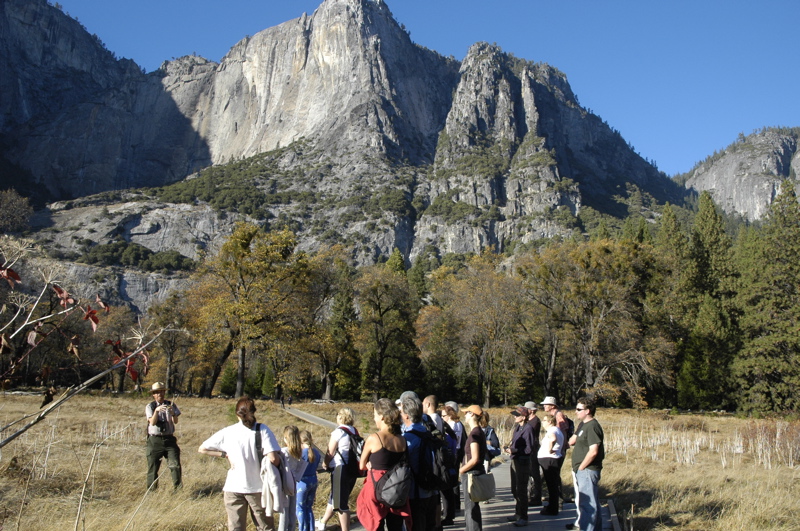
Friday morning we were all feeling fine. There was nothing much on our schedule except another 2 p.m. Ranger Walk (this time on park geology), and we had a sated feeling about the park that encouraged us to just hang around camp and have a relaxing morning. I asked Eleanor why she was looking so happy, and she said, “We’re just camping!” She meant we had no obligations, no pressing schedule, beautiful surroundings, endless opportunity, and all was well.
Many times we’ve been in a wonderful national park but I’ve had business obligations hanging over my head, worries about meeting deadlines, phone calls that needed to be returned, etc., and those things have tainted the enjoyment of the place. Finally this year the pressure of business seems to be abating, and I’m finding I’m more able to walk away from mental stress. The rest of the family can sense that, and I think that’s helping them relax as well.
In Yosemite I haven’t been free from the duties of my business but I have managed to compartmentalize them. I have allotted 60 minutes in the early morning to write before Emma is up, half an hour in the late afternoon in the center of the village to check voicemail and maybe briefly return a call, and an hour in the evening to respond to email at the hotel. It helps that the news from the business and from my friends has been uniformly good. The associates who help me run Airstream Life are all independent professionals who can generally take care of whatever comes up without my intervention, which is the way any good manager should want it.
In the afternoon Eleanor and I left Emma in the care of Robert and Kelli for a couple of hours so we could explore the Yosemite Museum (native baskets, an exhibit of climbing photos from 60s, obsidian arrowheads) and so Eleanor and I could visit the Ahwanee together. Sitting on the big couch by the fireplace is a romantic experience. I have to admit that the fireplace is one advantage of our house over the Airstream on a cool fall evening.
I’d like to come back in summer so we can hike to Half Dome (16 miles roundtrip), or perhaps do some backcountry camping in our tent. I did a little research on those possibilities for a future trip. But for now it is time to head south. This is the irony that I was alluding to earlier. The final days of our full-time travels are approaching quickly, and there’s much more we want to do before we pull into the carport in Arizona. I’ll talk about that in greater detail in a future blog entry.
Today we hitched up and moved south about 130 miles to Visalia, where we are courtesy parking at the home of blog readers Roger and Roxy. They’ve got a nice concrete pad next to their house and have generally rolled out the red carpet to us, with wifi, 30-amp electric, and water. They even moved their Airstream to the curb so we could park on the pad inside their fence. When an Airstreamer moves their own treasured trailer to the curb, it’s like offering their own bed, so we feel honored.
November 9, 2007 at 6:34 pm · Filed under Places to go
I’ve been looking at the maps for Yosemite and realizing that the convoluted nature of the roads means it can be a very long drive to go a very short distance (as the crow flies). From our campsite, we can look up and see a sheer cliff of granite, above which is Glacier Point. Glacier Point is a spectacular place to view the entire Yosemite Valley and I wanted to go there.

It would be simple to get to Glacier Point if you had a helicopter. It is 3,200 feet above us and perhaps a half mile to the southwest. Not far at all. But that’s like saying outer space isn’t very far. After all, it’s only an hour’s drive away if your car can go straight up.
For us earth-bound residents, there are two ways to get to Glacier Point. You can hike the “Four Mile Trail” which zig-zags steeply up the mountainside. This was the historical route for early visitors to the valley, and it’s climbing all the way. I would expect it to take us about eight hours to get up that route.
The other method is to drive out of the valley on Route 41, climbing steadily and winding constantly, until you reach the Glacier Point Road on the left. Then keep climbing and twisting until at last you reach Glacier Point. It’s about 25 miles and takes 45 minutes to drive. Once you’ve completed the drive, you are almost exactly where you started, except 3,200 feet higher and lightened by a couple of gallons of fuel (which currently costs $3.77 per gallon at Wawona, by the way). It felt faintly ridiculous to have done all that driving to end up where we started, but the view from Glacier Point made it all worthwhile.
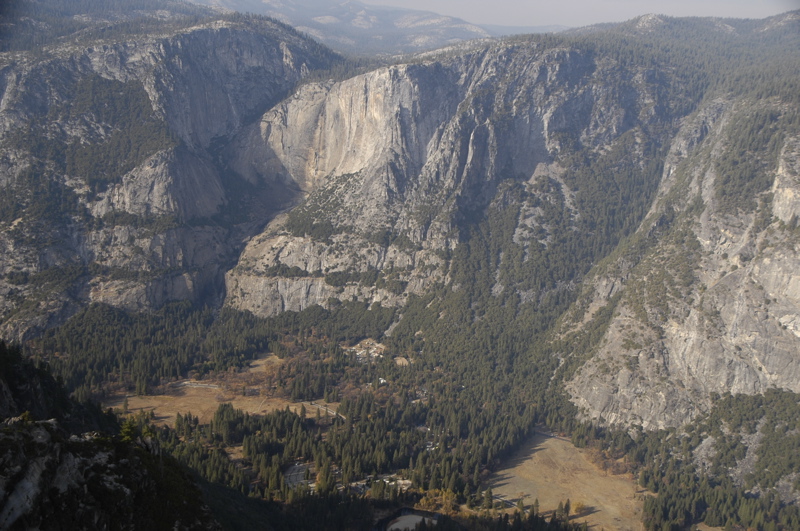
There are four managed burns going on in the park right now, which occasionally send layers of brownish smoke through the valley and obstruct the view, but we found that over the course of the day the view clears. Even with a light haze and occasional smoke, the viewing was superb. The valley is laid out before you like a model train set. We could see almost everything, including our Airstream, glinting through a gap in the trees.

While we were up around 7000 feet, we stopped off to hike to Sentinel Dome, which is another great viewing spot. That’s a relatively easy 2.2 mile roundtrip, even in the thin air of 7,000 feet, is worth doing if you are passing by on Glacier Point Road.
 The next stop was near the southern entrance of the park at Wawona, the Mariposa Grove of Giant Sequoia trees. These trees are absolutely incredible. The Pacific Coast Redwoods are magnificent and humbling as they tower in the fog, but the Giant Sequoias (close relatives) are just plain huge. They aren’t taller than the Coast Redwoods but they are bigger in diameter, and that has a tremendous impact on how you perceive them from the ground. Even a fallen Sequoia lying on its side will tower over a human. They are the largest living things on earth, and also the longest-lived (up to 3,000 years old). The Grizzly Giant in the photo is estimated at 1,790 years old. It’s worth the trip to visit the Sequoias, even if it means 25 miles of hairpins curves on Route 41.
The next stop was near the southern entrance of the park at Wawona, the Mariposa Grove of Giant Sequoia trees. These trees are absolutely incredible. The Pacific Coast Redwoods are magnificent and humbling as they tower in the fog, but the Giant Sequoias (close relatives) are just plain huge. They aren’t taller than the Coast Redwoods but they are bigger in diameter, and that has a tremendous impact on how you perceive them from the ground. Even a fallen Sequoia lying on its side will tower over a human. They are the largest living things on earth, and also the longest-lived (up to 3,000 years old). The Grizzly Giant in the photo is estimated at 1,790 years old. It’s worth the trip to visit the Sequoias, even if it means 25 miles of hairpins curves on Route 41.
This time of year the light fades early behind the mountains, and by 4:30 the Sequoia grove was getting too dim for photography. We hustled back to the cars and found ourselves driving back in the dark at 5:15. On the mountain tops we could see the prescribed forest fires glowing like lava on a volcano.
Back on the hotel’s wifi I reviewed the weather for the next few days and it looks like Sunday will bring some rain. We were thinking we’d head out on Saturday anyway, and the weather report solidified the decision. It is also going to get colder in Yosemite next week, possibly with a little snow overnight. We made the right choice zipping down through northern California to get here before the weather started to change. Now, it’s time to get back to the valley for a week of work, repairs, maintenance, and planning of the next trips.
November 8, 2007 at 8:43 pm · Filed under Travel / lifestyle musings
We started off slow in Yosemite. On Wednesday morning I got up early and spent the entire morning dawdling over work rather than rushing out and hiking the park. This may seem like a cardinal sin in Yosemite, but I felt like getting some things cleaned up and I was taking advantage of the fact that Robert was running his generator. We’re plugged into it. Since Robert ran the generator for about four hours, we recharged at the rate of about 4 amps/hr and avoided draining the batteries in the morning when I was using the laptop and our furnace use was high.
I’ve found it’s better to avoid using power than to try to recoup it, because you use it far faster than you can recharge. It’s easy to consume 10-20 amps per hour with just a few lights and the furnace cycling on and off, but as I’ve pointed out before, the batteries will only recharge at a certain rate with a 2-stage charger no matter how big your generator is. So two hours of evening usage at 16 amps/hour will take about eight hours to get back with the generator!
I didn’t make the family sit inside while I fiddled with the computer, however. Emma and Allison are always off playing. Kelli and Robert headed off for a walk, and around 2 pm we all headed out for a Ranger program about wildlife in the park. We saw woodpeckers, deer, and red-tailed hawks, but Emma and Allison wanted to see a pika. They live only above the treeline. To see those elusive little critters we’d need to drive about an hour up to Tuolumne.
Yosemite Valley is really more of a small town rather than a quiet park site. It’s much more developed than many other national parks, but this concentrates the visitor impact in a relatively small area, leaving most of the park wild. There’s a great visitor center, theater, educational info, store, post office, etc in the village, and if I stand still I can even make a call once in a while — not that I want to.
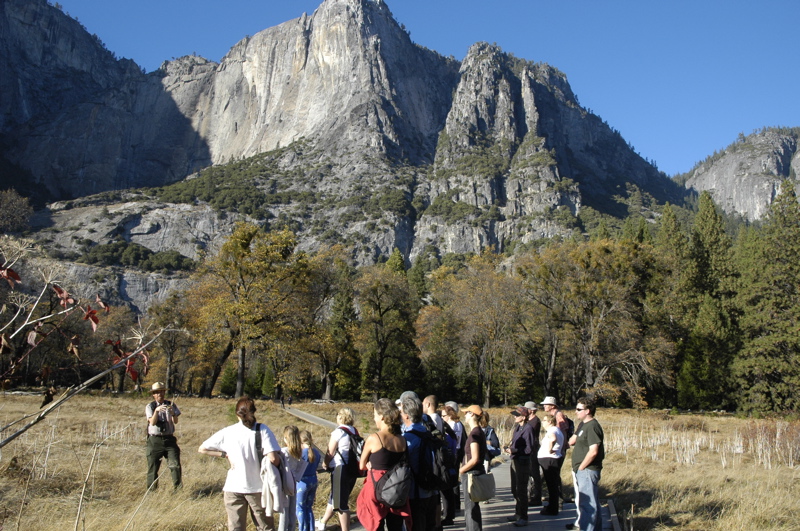
Photographically the village (and indeed, the entire park) is ideal. Stand near the meadow for great scenes in every direction. You don’t have to go far to find pictures in Yosemite.
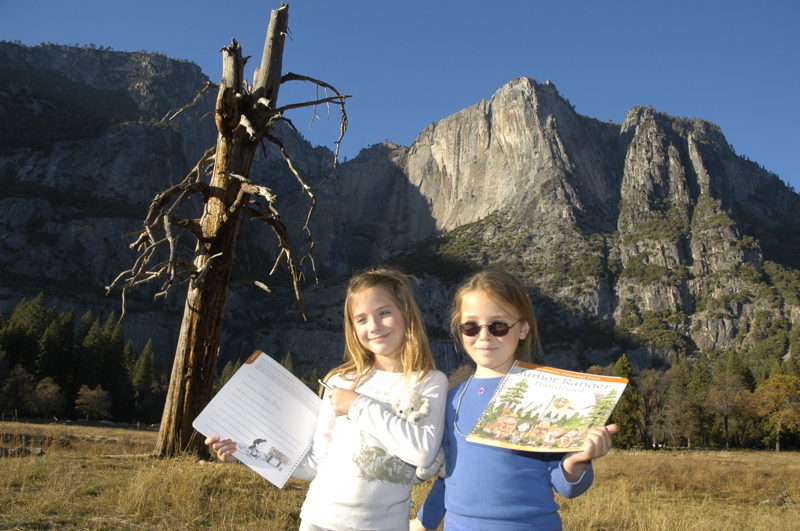
As I mentioned yesterday, Kelli and I are making a regular pilgrimage to the Ahwanee Hotel to borrow their wifi. There is a place in the hotel where you can sit on an overstuffed couch or chair and use your laptop in total comfort. After I had been there half an hour, the staff came over to light a fire in the giant stone fireplace, which warmed me nicely against the cool breeze floating in from the terrace.
The Ahwanee was built in 1927 as part of an effort to make America’s fledgling national park system more attractive to visitors. It’s a beautiful structure, with native American designs embossed in the concrete floors, hung on the walls, painted onto columns, and integrated in every aspect of the architecture. It’s old, rustic, and handsome without being rickety or overly fussy. I’d love to spend a couple of days there but the rooms start at about $385 a night. Our quiet spot half a mile away in the trees is $20 per night, which fits our budget better. Of course, we can’t schedule a masseuse and we have to ration our electricity, but we all see the same scenery.
Speaking of limited utilities, we decided that rather than rationing our water as severely as we did in Yellowstone, we’d live a little more luxuriously. Robert has a pair of 5-gallon buckets into which we can dump gray water. It’s a short walk to a graywater dump by the campground bathrooms, and it turns out that using the two buckets is a lot easier than the traditional “blue tank” in this particular setting.
But refilling our fresh water tank is a bit harder. I tried a 5-gallon flexible plastic water carrier that I bought at Wal-Mart, but it was a real pain, and the spout was too short. So after dark Robert and I hooked up all the water hose we both owned and strung together over 200 feet from the fresh water spigot all the way to our Airstreams. It was quite a production but after a few minor missteps we both ended up with full fresh water tanks and empty gray tanks (and no, we didn’t dump any on the ground). Thus we are set for another several days.
Is this the kind of adventure you want in Yosemite, or are you the type who would go for the Ahwanee every time? It’s a good question to ask oneself before emarking on the full-time life. Sometimes there are the awkward moments, like when I was carrying two sloshing buckets of gray water over to the dump. It’s up to you to decide if the compromises balance the rewards. For our part, we are staying in the Airstream.
November 7, 2007 at 7:57 pm · Filed under Roadtrips
We are in Yosemite at last, and it’s great. The weather is beautiful (upper 60s, sunny, and dry, low 30s at night), the pines are tall, and the granite of the sheer cliffs is glowing brightly in the sun. Best of all, there’s hardly anyone here by Yosemite standards.
Getting here was a bit of a challenge. Route 49 is highly scenic and dotted with cute western downtowns, but a tiring road to pull a long trailer on. Those who are averse to sharp turns and rolling terrain should, as they say, “seek alternate routes.”
It got even more interesting when we turned onto Route 120 into Yosemite. The Old Priest Grade has been replaced by a shallower but much more twisty route for several miles. The hairpin turns overlooking a steep drop where you’d most want to see a guardrail seem to rely on Darwinism rather than protectionism, e.g., if you drive too fast (over 25 MPH or so) you will leave the gene pool permanently. We kept the truck in low gear and took our time.
Good thing the brakes are working again, too. Coming into Yosemite Valley via Rt 120 means a lot of descending. We paused about 3/4 of the way down and I could smell the brakes. Overall, I’d rather take Rt 140 but it is still closed to vehicles over 28 feet long (total length) due to a rockslide and CalTrans says it will be a looooong time before that changes. On the way out of the park, we’ll take Rt 41 to Fresno. It features a hefty climb out of the village, but it is the only viable route to the south, and that’s where we are headed next.
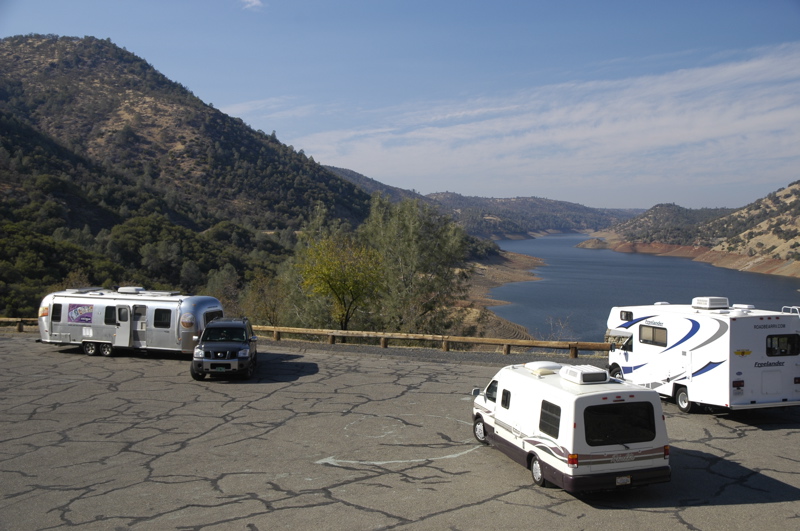
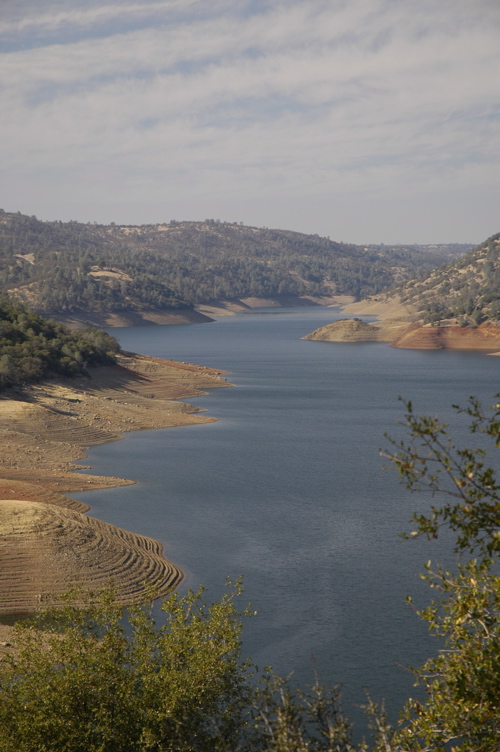 On the way in we stopped for lunch along a lake just outside the park. It’s a beautiful area to visit anywhere around here. Hard to go wrong. That’s the flip side of the hairy roads. I wanted to get into the park by 2 pm but the scenery and twisting roads made us slow down to the point that we arrived sometime after three.
On the way in we stopped for lunch along a lake just outside the park. It’s a beautiful area to visit anywhere around here. Hard to go wrong. That’s the flip side of the hairy roads. I wanted to get into the park by 2 pm but the scenery and twisting roads made us slow down to the point that we arrived sometime after three.
We have once again linked up with the McDills, and the girls are constantly off in the woods that surround all the campsites, playing adventure games. We had to establish boundaries so that they wouldn’t disappear on us. Robert is indulging his fetish for campfires (which is fine with me) and since there is absolutely no chance of gaining solar power in here due to the Ponderosa pines everywhere, the McDills are also graciously allowing us to plug into their Yamaha 3000 generator in the evening. That helps, since overnight temperatures are dipping into the 30s each night and we are using the furnace quite a lot.
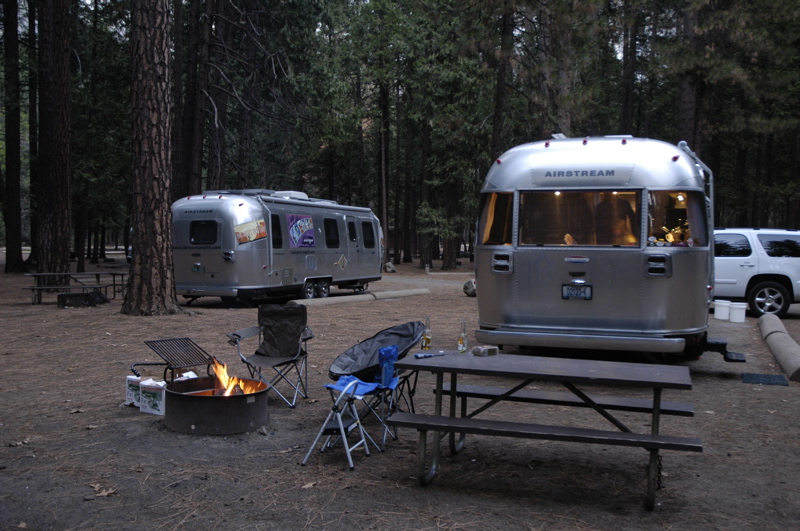
The photo above of Upper Pines campground shows the typical conditions in the early afternoon. Although the sun is shining brightly above, in the forest it is fairly dark all the time. It reminds me a little of our very dark and damp stay in the redwood forest last summer.
Internet is only available at the Ahwanee Hotel, so Kelli and I are making a daily pilgrimage there to get our email and post our respective blogs. Verizon does have limited cell service in the center of the village but it is “extended network” and as is commonly the case, that means my Verizon data card won’t work. Verizon claims it will work everywhere I can make a voice call on my Verizon phone, but it just is not true. I look forward to the day they finally get it all together.
« Previous entries ·
Next entries »
 The seller is asking for $7,200 or best offer, which seems a tad high, but the trailer is very well kept. It was clearly loved by someone and maintained. The interior is all original except for fabrics, and it has a good roomy floorplan up front, twin beds amidships, and a spacious rear bath. The body is in good shape with no major dents.
The seller is asking for $7,200 or best offer, which seems a tad high, but the trailer is very well kept. It was clearly loved by someone and maintained. The interior is all original except for fabrics, and it has a good roomy floorplan up front, twin beds amidships, and a spacious rear bath. The body is in good shape with no major dents. While we were poking around at the salvage yard we also spotted a very tired 1976 Airstream Caravanner 25 (needing a complete restoration and sporting some poorly repaired rear dome segments), and this “so ugly it’s cute” 1962 Dodge 880.
While we were poking around at the salvage yard we also spotted a very tired 1976 Airstream Caravanner 25 (needing a complete restoration and sporting some poorly repaired rear dome segments), and this “so ugly it’s cute” 1962 Dodge 880.












